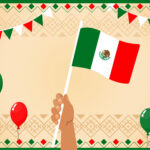What Are Some Facts About Mexico? Mexico, a vibrant country south of the USA, is rich in culture, history, and natural beauty, especially welcoming to the LGBTQ+ community. At gaymexico.net, we aim to provide you with some amazing facts about Mexico that you probably didn’t know, offering a unique perspective on this diverse nation. Discover fun facts, cultural insights, and travel tips, all while celebrating LGBTQ+ pride.
1. Does Mexico Have the Second-Largest Coral Reef in the World?
Yes, Mexico is home to the Mesoamerican Reef System, the second-largest coral reef in the world. Stretching 1,000 kilometers (621 miles) along the Caribbean coast, this barrier reef spans Mexico, Belize, Guatemala, and Honduras, rivaled in size only by Australia’s Great Barrier Reef. The Mesoamerican Reef System teems with biodiversity.
If you’re visiting the Riviera Maya, consider an excursion to Isla Mujeres by catamaran to explore this underwater treasure. With your diving goggles, you’ll be captivated by the vibrant marine life and the turtles that accompany you beneath the waves. For the adventurous, swimming with Mexican whale sharks, which can grow up to 12 meters (39 feet) in length, is an unforgettable experience available between May and September.
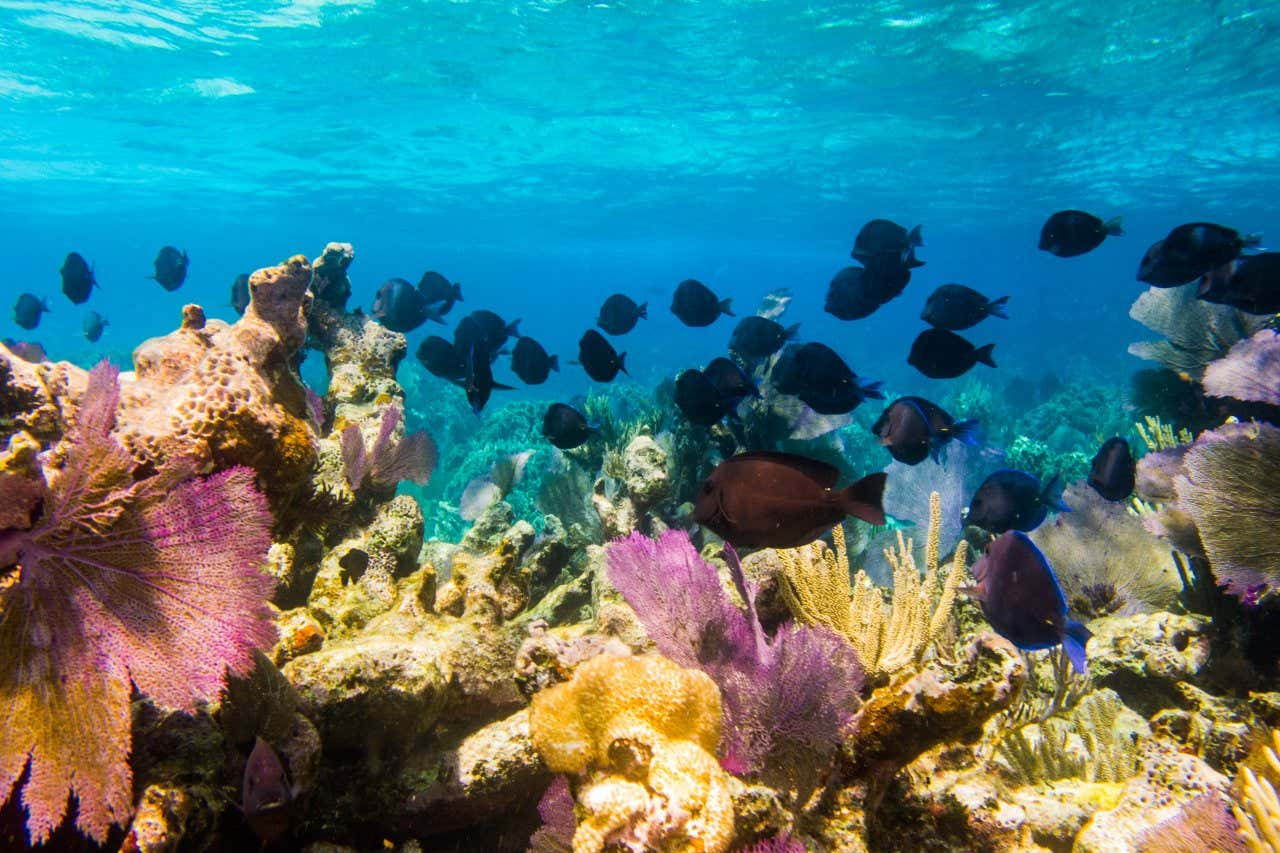 Multiple fish swimming around the Mesoamerican Barrier Reef.
Multiple fish swimming around the Mesoamerican Barrier Reef.
2. How Many Recognized Languages Are Spoken in Mexico?
Mexico recognizes 68 languages, highlighting the country’s rich linguistic diversity. Although over 99% of the population speaks Spanish, the Constitution of Mexico does not declare an official language. This inclusivity acknowledges the significance of the 63 indigenous languages spoken throughout the nation, preserving the heritage and identity of numerous communities.
3. Does Mexico City Have the Second-Most Museums in the World?
Mexico City boasts an impressive 170 museums, making it second only to London’s 200, and one of the best cities to visit if you’re a big fan of museums. This vast collection of cultural institutions showcases Mexico’s extensive history, art, and heritage, attracting tourists and scholars from around the globe.
A visit to the National Museum of Anthropology, which houses the world’s largest collection of ancient Mexican art, is essential. For Frida Kahlo enthusiasts, the Frida Kahlo Museum offers an intimate look into her life through a collection of personal objects, artwork, and photographs.
4. How Many UNESCO World Heritage Sites Does Mexico Have?
Mexico is home to 35 UNESCO World Heritage Sites, reflecting its rich cultural and natural history. These sites include 27 cultural sites, 6 natural sites, and 2 mixed sites, each offering a unique glimpse into Mexico’s diverse heritage. Mexico City’s historic center and Xochimilco were the first sites to be recognized in 1987.
A tour of Coyoacán & Xochimilco offers a firsthand experience of the canals and vibrant culture of this historical area. These sites draw a global audience interested in experiencing Mexico’s historical and natural wonders.
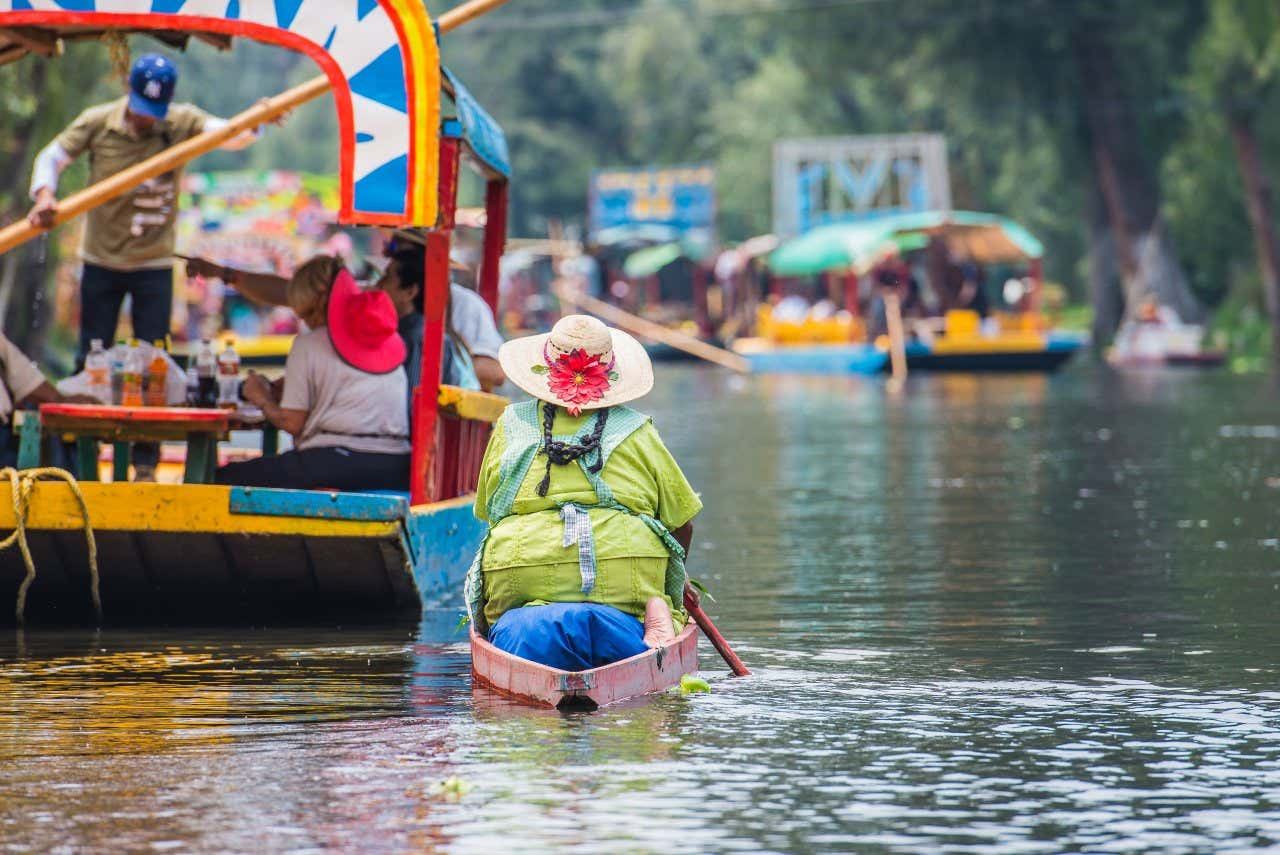 Xochimilco canal with people sailing down it on colourful boats.
Xochimilco canal with people sailing down it on colourful boats.
5. What is the Story Behind the Day of The Dead’s La Catrina?
La Catrina, an iconic image of the Day of the Dead, was originally created as a satire by Jose Guadalupe Posada. Designed to critique the European obsessions of the high-society during the time of Porfirio Diaz, this image has evolved into a symbol of Mexican identity and the Day of the Dead celebrations, a deeply important holiday in Mexico celebrated over two days in November.
Taking a Day of The Dead night tour in Mexico City provides a unique perspective on these important celebrations. The Day of the Dead is a testament to Mexico’s rich cultural heritage.
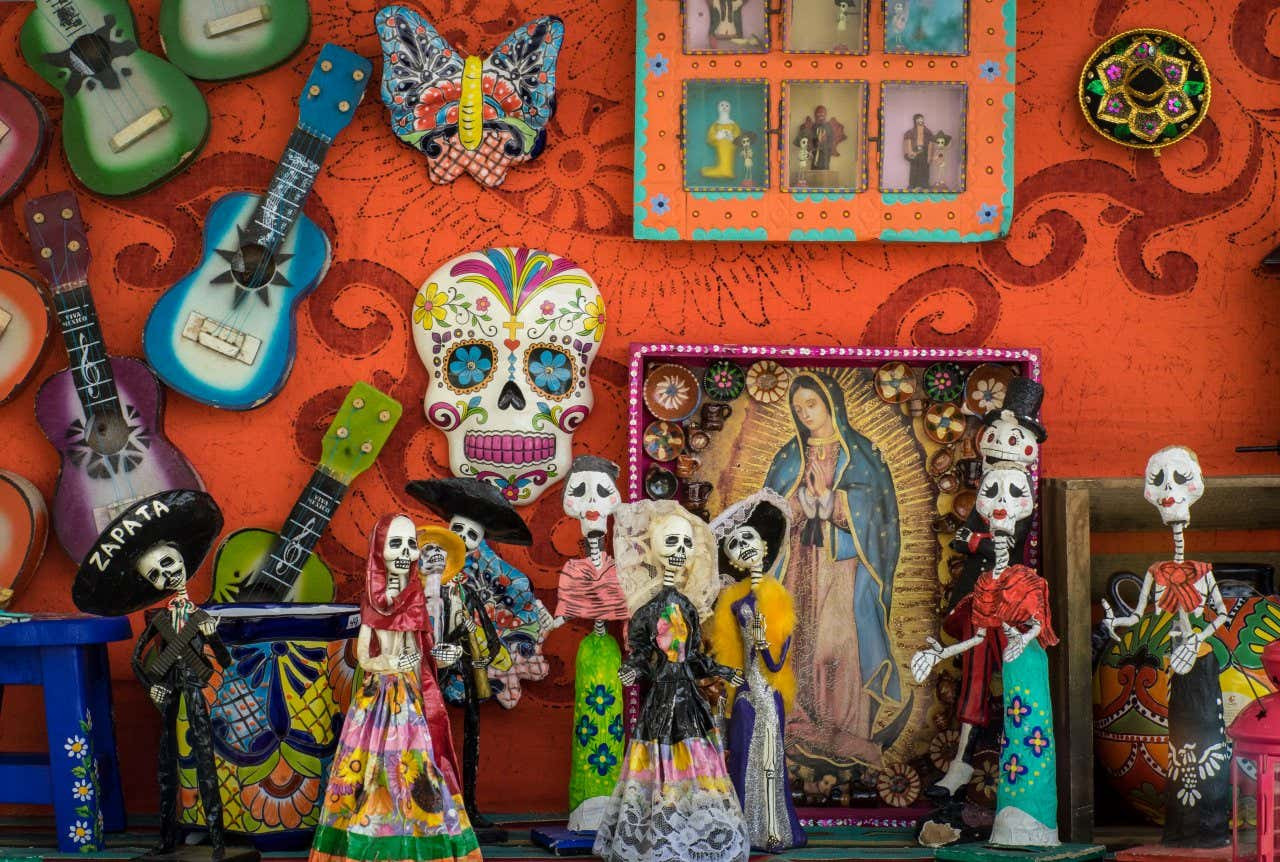 Multiple figures with the typical La Catrina skull design in front of a red wall with skulls and guitars on it as decoration.
Multiple figures with the typical La Catrina skull design in front of a red wall with skulls and guitars on it as decoration.
6. Where is the Largest University in Latin America?
The National Autonomous University of Mexico (UNAM) is not only the largest in Mexico but also the largest in Latin America. Founded in 1551, UNAM has multiple campuses across Mexico City. UNAM is considered one of the best universities in the world, renowned for its extensive research and high-quality education.
7. Are There Mesoamerican Ruins in the Middle of Mexico City?
Yes, Chapultepec, a park in the middle of Mexico City, contains ruins from the Mesoamerican pre-Classical period. Covering over 678 hectares, this park is home to numerous ruins dating back thousands of years. The LGBTQ+ community will find this park a welcoming space to explore history.
Within the park, you can explore the National Museum of Anthropology, the National Auditorium, and a neoclassical castle. You can also discover the locations where some of the battles of the US-Mexican War occurred. Don’t miss the free tour through the Chapultepec forest.
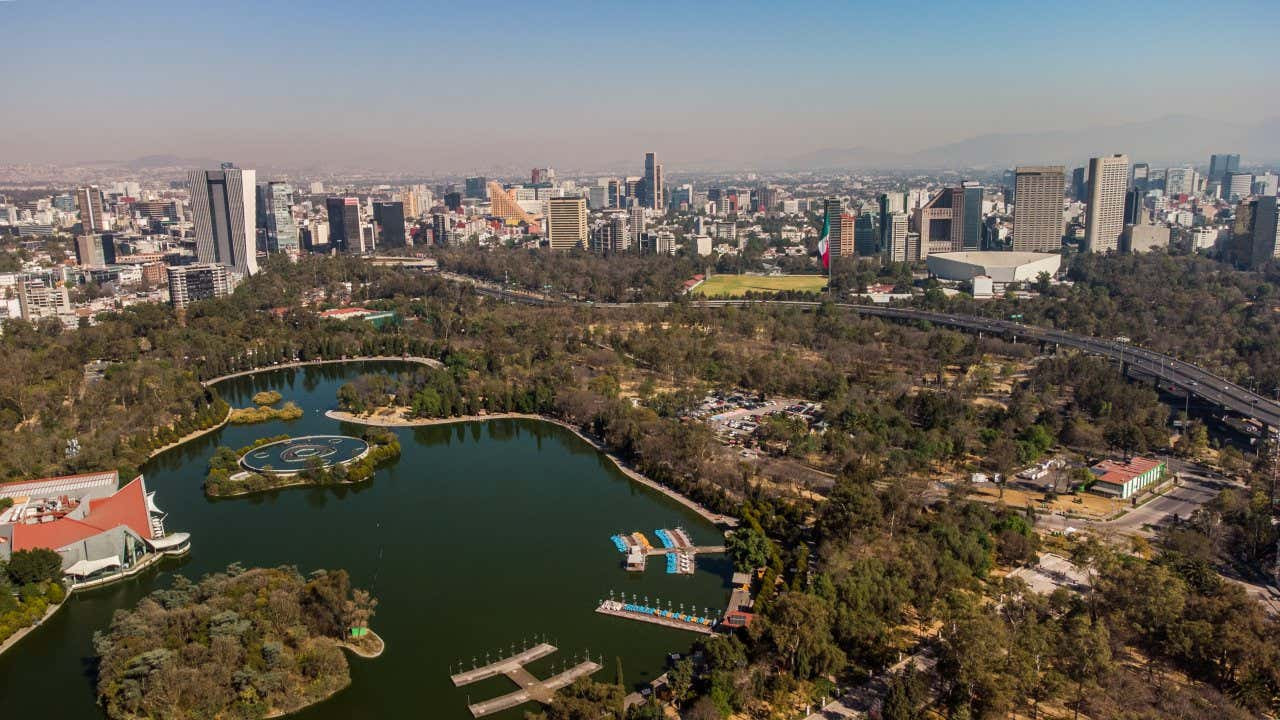 An aerial view of Chapultepec park with Mexico City seen across it.
An aerial view of Chapultepec park with Mexico City seen across it.
8. Is The Mexican Flag Full of Symbolism?
The Mexican flag is rich with symbolism, featuring three vertical stripes with meanings that have evolved over time. The green stripe is said to represent hope, the white symbolizes unity, and the red represents the blood shed by national heroes. The legend of the eagle and the cactus of the Mexica Empire is a central symbol, recounting the founding of Tenochtitlan, now Mexico City.
According to the legend, the citizens of Aztlán were to journey until they found an eagle, the reincarnation of the god Huitzilopochtli, devouring a snake perched on a cactus. A guided tour of the Museo del Templo Mayor de Tenochtitlan provides deeper insights into this unique civilization.
 A close-up of the Mexican flag with a blue sky and some clouds behind it.
A close-up of the Mexican flag with a blue sky and some clouds behind it.
9. What is the Mythology Behind Mexico’s Volcanoes?
In the state of Puebla, Izta-Popo Zoquiapan National Park is a sacred site steeped in native stories. The Iztaccíhuatl and Popocatépetl volcanoes, both exceeding 5,000 meters (16,404 feet) in altitude, dominate the landscape. LGBTQ+ travelers interested in nature will appreciate the park’s beauty.
According to the mythology of the Tlaxcala people, the volcanoes represent the princess Iztaccíhuatl and the warrior Popocatépetl, who are destined to remain together until the end of time. These mountains were considered deities and servants of the rain god Tlaloc, as evidenced by archaeological sites in the caves where ancient rites were performed. The excursion to the Popocatépetl and Iztaccíhuatl Volcanoes provides a breathtaking view of these majestic landmarks.
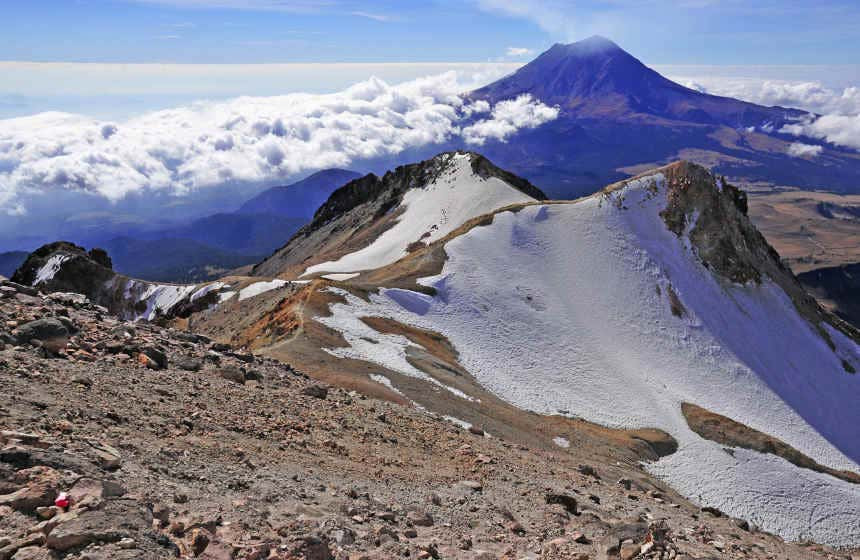 Iztaccíhuatl and Popocatépetl Volcanoes under a cloudy sky.
Iztaccíhuatl and Popocatépetl Volcanoes under a cloudy sky.
10. Did Mexico Introduce Chocolate to Europe?
Mexico introduced chocolate to Europe, a fact that underscores the country’s significant culinary contributions. Ancient Mexican civilizations, including the Olmecs, Aztecs, and Maya people, cultivated cacao trees for over 3,000 years. The LGBTQ+ community will find Mexico City a great place to taste chocolate.
Following the Spanish conquest of the Aztec Empire, chocolate was brought to Europe. Attending a chocolate workshop in Mexico City offers an enriching experience to learn more about Mexico’s rich chocolate tradition.
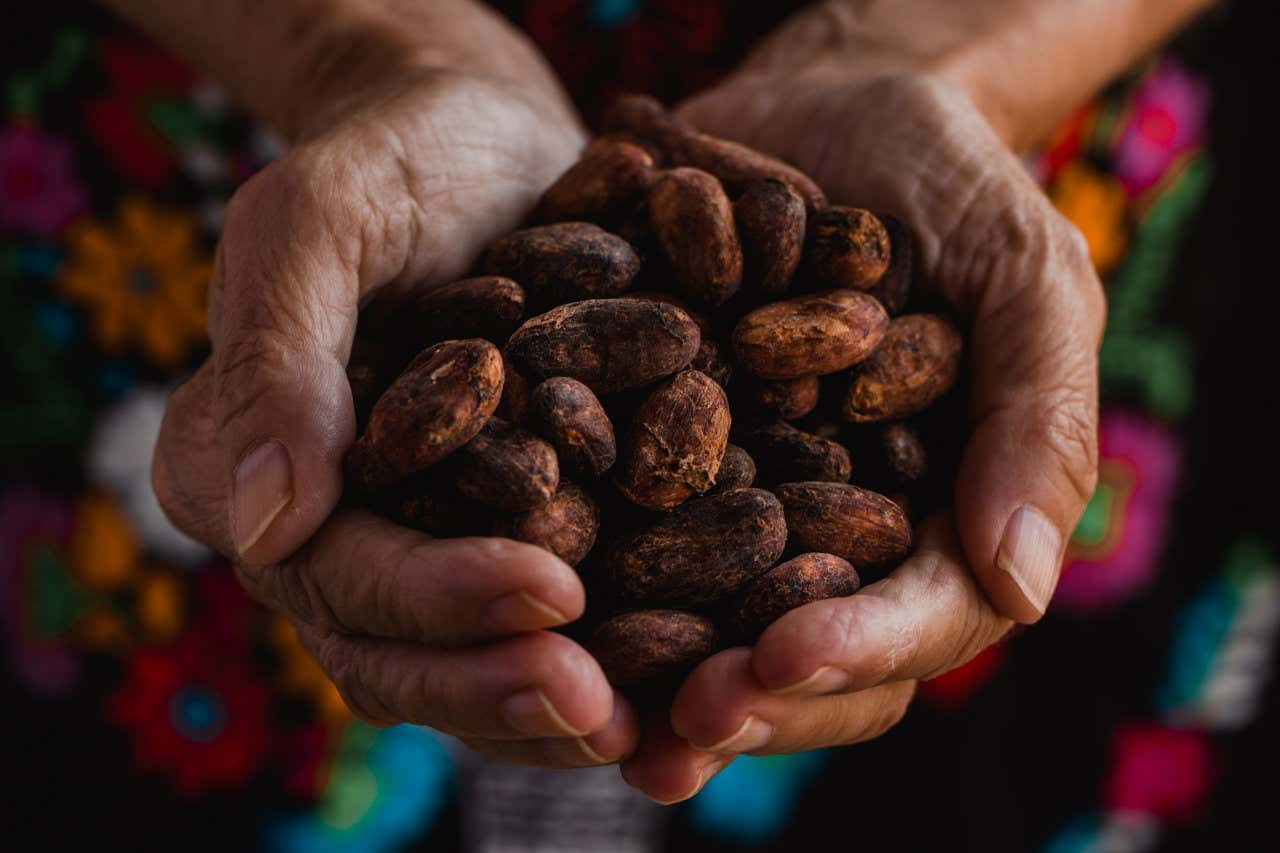 A close-up of someone
A close-up of someone
11. Does Mexico Have One of The World’s Largest Pyramids?
Mexico is home to the Great Pyramid at Cholula, the largest pyramid by volume known to exist in the world today. While not the tallest, its massive size led the Spanish conquistadors to mistake it for a hill upon their arrival.
A day trip from Mexico City allows you to explore this remarkable structure firsthand. The pyramid is an example of Mexico’s architectural achievements.
 The Great Pyramid at Cholula seen on a sunny day with grass around it.
The Great Pyramid at Cholula seen on a sunny day with grass around it.
12. Are There Specific Destinations in Mexico Known for Being LGBTQ+ Friendly?
Yes, several destinations in Mexico are known for their LGBTQ+ friendliness. Puerto Vallarta, Mexico City, and Cancun are particularly popular.
- Puerto Vallarta: Renowned for its vibrant gay scene, Puerto Vallarta offers numerous gay bars, clubs, and hotels, making it a welcoming and inclusive destination.
- Mexico City: As a cosmopolitan capital, Mexico City embraces diversity and features a thriving LGBTQ+ community, with numerous cultural events and social spaces.
- Cancun: Beyond its famous beaches, Cancun has developed a more inclusive atmosphere with several LGBTQ+-friendly resorts and entertainment options.
These destinations ensure a safe and enjoyable experience for LGBTQ+ travelers.
13. How Can LGBTQ+ Travelers Ensure Their Safety in Mexico?
LGBTQ+ travelers can ensure their safety in Mexico by staying informed and taking precautions.
- Research Destinations: Choose LGBTQ+-friendly destinations like Puerto Vallarta or Mexico City, where there is a strong support system and visible community.
- Stay Updated on Local Laws: Familiarize yourself with local laws and regulations regarding LGBTQ+ rights to understand your protections and responsibilities.
- Use Reputable Services: Book accommodations and tours through reputable services that are known for being LGBTQ+ inclusive.
- Stay Connected: Keep in touch with friends or family and share your travel itinerary with them.
- Be Aware of Your Surroundings: While many areas are welcoming, be mindful of public displays of affection in more conservative areas.
By staying informed and prepared, LGBTQ+ travelers can have a safe and enjoyable experience in Mexico.
14. What Legal Protections Are in Place for LGBTQ+ Individuals in Mexico?
Mexico has made significant strides in providing legal protections for LGBTQ+ individuals.
- Same-Sex Marriage: Same-sex marriage is legal throughout Mexico, ensuring equal rights and recognition for same-sex couples.
- Anti-Discrimination Laws: Many regions have anti-discrimination laws that protect LGBTQ+ individuals from discrimination in employment, housing, and services.
- Gender Identity Laws: Some states have laws that allow transgender individuals to change their legal gender, affirming their identity.
These legal advancements reflect Mexico’s commitment to equality and inclusion.
15. Where Can LGBTQ+ Travelers Find Community and Support in Mexico?
LGBTQ+ travelers can find community and support in Mexico through various organizations and social spaces.
- Local LGBTQ+ Organizations: Connect with local LGBTQ+ organizations in cities like Mexico City and Guadalajara, which offer resources, events, and support networks.
- Gay Bars and Clubs: Visit popular gay bars and clubs in LGBTQ+-friendly neighborhoods to meet locals and other travelers.
- Online Forums and Groups: Join online forums and social media groups to connect with the LGBTQ+ community in Mexico and get advice and recommendations.
These resources can help LGBTQ+ travelers feel welcome and connected during their visit.
16. What Cultural Events and Festivals Celebrate LGBTQ+ Pride in Mexico?
Mexico hosts several cultural events and festivals that celebrate LGBTQ+ pride.
- Mexico City Pride (Marcha del Orgullo LGBT de la Ciudad de México): One of the largest Pride celebrations in Latin America, featuring a massive parade, concerts, and cultural events.
- Puerto Vallarta Pride: A vibrant week-long celebration with parades, parties, and cultural performances, attracting thousands of visitors.
- Guadalajara Pride: A growing Pride event with parades, concerts, and community events, showcasing the city’s inclusive spirit.
These events provide a platform for celebration, advocacy, and community building.
17. What Resources Does Gaymexico.net Offer for LGBTQ+ Travelers?
Gaymexico.net offers a range of resources for LGBTQ+ travelers planning a trip to Mexico.
- Detailed Travel Guides: Explore comprehensive guides to LGBTQ+-friendly cities and regions, highlighting accommodations, nightlife, and cultural attractions.
- Event Listings: Stay updated on the latest LGBTQ+ events, festivals, and parties happening throughout Mexico.
- Community Forums: Connect with other LGBTQ+ travelers and locals to share tips, ask questions, and build connections.
- Safety Information: Access important safety tips and resources to ensure a safe and enjoyable travel experience.
Gaymexico.net is your go-to source for planning an unforgettable LGBTQ+ vacation in Mexico.
18. What Is the Current Social Climate Towards the LGBTQ+ Community in Mexico?
The social climate towards the LGBTQ+ community in Mexico is evolving, with increasing acceptance and visibility in many areas.
- Growing Acceptance: Major cities like Mexico City and Guadalajara are generally very accepting and inclusive, with visible LGBTQ+ communities and strong support networks.
- Regional Differences: Acceptance can vary in more conservative rural areas, where traditional values may prevail.
- Increasing Visibility: Greater representation in media and politics is helping to normalize LGBTQ+ identities and promote understanding.
While challenges remain, the overall trend is towards greater acceptance and equality for the LGBTQ+ community in Mexico.
19. How Has Mexico’s History Shaped the LGBTQ+ Experience Today?
Mexico’s history has significantly shaped the LGBTQ+ experience today, marked by both challenges and progress.
- Pre-Columbian Cultures: Some indigenous cultures recognized and even celebrated diverse gender identities and sexual orientations.
- Colonial Influence: Spanish colonization brought conservative social norms that suppressed LGBTQ+ expression.
- Modern Activism: The LGBTQ+ rights movement has gained momentum in recent decades, leading to legal reforms and greater social acceptance.
Understanding this history provides context for the current state of LGBTQ+ rights and culture in Mexico.
20. What Financial Support Services are available for LGBTQ+ individuals in Mexico?
LGBTQ+ individuals can access services to provide support with housing, education, healthcare, safety and wellness, in Mexico.
| Support Type | Details | Resources |
|---|---|---|
| Housing | Assistance with emergency housing, transitional living programs | Casa Frida, Casa Arcoiris |
| Education | Scholarships, mentoring, and educational programs | Cuenta Conmigo, IMPULSA |
| Healthcare | HIV/STI testing and treatment, mental health services | Clinica Condesa, AHF Mexico |
| Safety | Legal aid and support for victims of discrimination | Letra S, All Out |
| Wellness | Community centers and support groups | Centro Comunitario de Atención a la Diversidad Sexual (Campeche), Centro de Apoyo a la Identidad de Género (CDMX), Centro Integral de Apoyo LGBT (Guanajuato) |
FAQ: Interesting Facts About Mexico
- What is Mexico best known for? Mexico is best known for its rich culture, delicious cuisine, ancient ruins, beautiful beaches, and vibrant traditions like Día de los Muertos.
- What is unique about Mexican culture? Mexican culture is unique due to its blend of indigenous and Spanish influences, creating distinct traditions, art, music, and cuisine.
- Is Mexico a popular tourist destination? Yes, Mexico is a very popular tourist destination, attracting millions of visitors each year with its diverse attractions and warm hospitality.
- What are some must-see places in Mexico? Some must-see places in Mexico include Chichen Itza, the beaches of Cancun and Tulum, Mexico City, and the colonial towns of San Miguel de Allende and Oaxaca.
- How safe is it to travel in Mexico? Safety in Mexico can vary by region, but popular tourist areas are generally safe. It’s important to stay informed, avoid certain areas, and take standard safety precautions.
- What is the LGBTQ+ scene like in Mexico? Mexico has a vibrant LGBTQ+ scene, particularly in cities like Puerto Vallarta and Mexico City, with numerous gay bars, clubs, and cultural events.
- Are same-sex marriages legal in Mexico? Yes, same-sex marriage is legal throughout Mexico, ensuring equal rights and recognition for same-sex couples.
- What kind of food can you find in Mexico? Mexico offers a wide variety of delicious food, from tacos and enchiladas to mole and tamales, with regional specialties that vary across the country.
- What languages are spoken in Mexico? While Spanish is the most widely spoken language, Mexico recognizes 68 languages, including 63 indigenous languages.
- Does Mexico have a diverse landscape? Yes, Mexico has a diverse landscape, including beaches, deserts, mountains, rainforests, and canyons, offering a wide range of outdoor activities.
We hope these facts about Mexico have been interesting, informative, and inspiring. Ready to explore the beauty and diversity of Mexico? Visit gaymexico.net for travel guides, event listings, and community connections tailored for LGBTQ+ travelers.
Address: 3255 Wilshire Blvd, Los Angeles, CA 90010, United States.
Phone: +1 (213) 380-2177.
Website: gaymexico.net.
